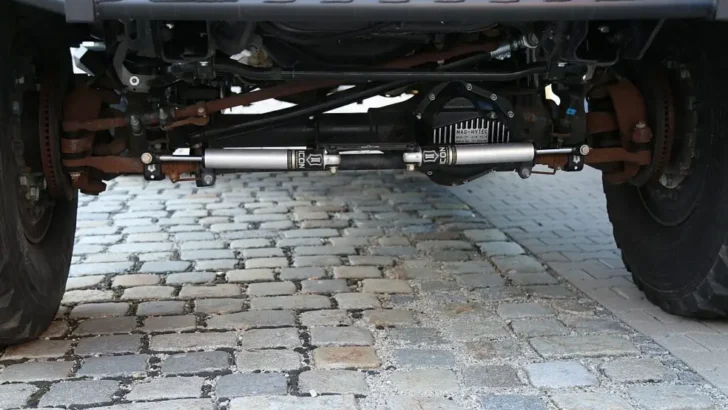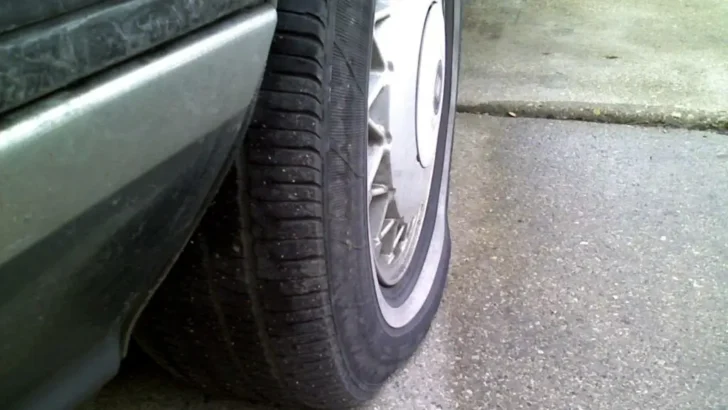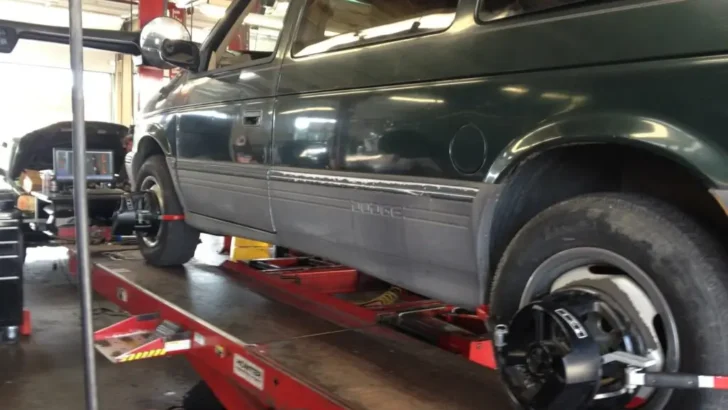Have you ever driven and noticed that it was difficult to turn the steering wheel to the left but not the right? You are not alone; this is a common issue among drivers. In this blog post, we’ll investigate some potential causes and provide solutions – keep reading for more details!
If it’s difficult to turn the steering wheel to the right but not left, this could be due to a rack and pinion issue, an errant valve in the steering gear mechanism, an issue with the damper, low or uneven tire pressure, or improper front-end alignment.
Key Takeaway
- Your steering wheel could be hard to turn right but not left due to reasons such as low power steering fluid, a cracked or broken serpentine belt, clogged or malfunctioning valves in the rack, or faulty hoses causing fluid leaks, all of which can impede the hydraulic pressure needed for smooth steering operation.
- If your steering wheel becomes hard to turn, the solution typically involves addressing problems such as low power steering fluid, a loose or broken serpentine belt, improper tire pressure, a malfunctioning steering rack, or misaligned wheels.
- The cost to repair a steering wheel that is hard to turn right can range from $100 to $800, depending on the root cause of the problem and whether you choose to conduct the repairs yourself or hire a professional mechanic.
Why Is My Steering Wheel Hard to Turn Right But Not Left?

Power steering is often taken for granted, yet its absence makes turning the steering wheel incredibly challenging.
So when you experience difficulty turning left but not right, your first thought may be a problem with your pump or low fluid in that area – but could also be something else altogether.
Turning one way but not the other may be due to a malfunction in your steering system that provides directional support. Here is a list of issues that could make it difficult to turn right but not left:
1. Rack and pinion failure

The rack and pinion are essential elements of a car’s steering mechanism. They consist of an upright bar or rod that meshes with a gear wheel known as the pin, converting rotary motion from the steering wheel into a linear movement that turns the wheels. This type of system is widely used in modern cars and trucks.
One advantage of rack and pinion steering is its compact size compared to other methods, such as Ackermann steering. Furthermore, rack and pinion steering often provides more precise steering than other systems do. But what happens if your racks and pins wear out?
When driving down the road, you expect your car to respond to inputs from you. So it can be disconcerting when your steering wheel won’t turn right – there are a variety of reasons this might be happening; one possibility is that your rack and pinion have failed.
The rack and pin are responsible for translating the rotation of your steering wheel into linear motion, which in turn allows you to turn your wheels. If these components become damaged or inoperable, it becomes difficult or even impossible to turn your wheel in one direction – in this case right – while turning in another will become much harder.
Before inspecting your rack and pinion, first look for leaks. Make sure there isn’t any fluid escaping from the steering system; any potential issues should be located at the seals. Ultimately, it’s best to take your car to a mechanic shop so they can properly diagnose the situation.
2. Faulty valve in the steering gear mechanism

A valve in the steering gear mechanism provides hydraulic pressure to the steering system. It sits between the pump and steering system, controlling fluid flow between them. When turned, this valve opens, allowing fluid into the system for steering action.
This provides the pressure needed to turn the wheels. Once released, however, the valve closes and prevents fluid from flowing back into the pump, helping maintain hydraulic pressure in the system and protecting its components from damage.
One possible explanation for why it may be difficult to turn the steering wheel left but not right is a malfunctioning valve in the steering gear mechanism. When this valve goes bad, pressurizing the steering fluid makes turning difficult.
In some instances, pressure can build up so much that steering fluid leaks out. If you notice your level is low or signs of a leak, then it could be due to a faulty valve.
If your steering is acting up, then having it examined by a mechanic is recommended. They can accurately diagnose and fix any problems.
3. Problem with the steering damper

The steering damper is an accessory attached to a vehicle’s steering system that helps reduce the vibration of the wheel, giving drivers better control of their vehicle. They are especially beneficial on rough roads since they reduce vibration levels experienced by drivers.
Steering dampers may also be employed to adjust a vehicle’s steering response. For instance, if there is excessive body roll in the car, then adding a steering damper will stiffen up its response and help reduce body roll.
While not necessary for all vehicles, those who regularly traverse rough roads or need extra help controlling their vehicles might find these beneficial additions beneficial.
One potential reason why it may be difficult to turn the steering wheel in the right direction but not the left is a malfunction with its damper.
The damper acts like an elastic shock absorber and helps absorb any sudden movements of the wheel when they occur. If it’s not functioning properly, the wheel may feel heavy and difficult to turn.
4. Low or unequal tire pressure

Proper tire pressure is essential for the safe operation of any vehicle. Underinflated tires can lead to decreased fuel economy, reduced handling, and increased wear and tear; on the other hand, overinflated tires make for a jarring ride and are more likely to fail.
In either case, improper tire pressure poses risks; unequal pressure also makes driving harder – increasing accident risks.
Steering should be a relatively straightforward task – however, if you find that turning in one direction is becoming harder and harder, there could be an underlying issue with your tires.
One potential cause of your steering issues could be low tire pressure in one or more tires. This can throw off the balance of your car and make turning difficult.
Another possibility is uneven pressure distribution between each tire; this could also lead to premature wear on those tires.
If you’re experiencing difficulty turning the steering wheel, it is essential that your tires be checked as soon as possible to prevent further harm.
5. Improper front-end alignment

Alignment is essential for all cars, but especially so with front-end alignment. That’s because the front wheels are what steer the vehicle; if they’re not pointed in the right direction, pulling to one side or another and keeping going straight will become increasingly difficult.
Front-end alignment is also critical for tire wear. When the wheels are out of alignment, your tires will wear unevenly and need replacement sooner than if they had been properly aligned. Fortunately, front-end alignment is a relatively straightforward and inexpensive procedure that can be completed at most auto repair shops.
One possible explanation for why it can be difficult to turn the steering wheel in one direction is an incorrect front-end alignment. When wheels aren’t pointed in the same direction as the frame of your car, the pull will occur to one side and make turning more challenging.
Improper front-end alignment can cause premature tire wear and negatively affect the handling of your car. If you believe your vehicle’s alignment is off, it is essential to have it checked by a qualified mechanic says VehQ.
How To Fix a Steering Wheel That Is Hard To Turn Right
A steering wheel that’s hard to turn right but not left can typically be fixed by addressing issues such as low power steering fluid, a faulty serpentine belt, or incorrect front-end alignment.
Low Power Steering Fluid
If your steering wheel is difficult to turn, one of the first things to check is the level of your power steering fluid. This fluid helps maintain the smooth operation of the steering system, and if it’s low, it can cause stiffness or difficulty when turning. To fix this, simply top up the power steering fluid in the pump to the correct level.
Faulty Serpentine Belt
A cracked or broken serpentine belt is another common cause of a steering wheel being hard to turn. The serpentine belt has many important jobs within the engine, including providing power to the steering system. If it’s damaged, it can affect the function of your steering wheel. In this case, the solution would be to replace the serpentine belt.
Incorrect Front-End Alignment
An incorrect front-end alignment could also make it difficult to turn the steering wheel in one direction. When the alignment is off, it can create resistance, making your steering wheel harder to turn. To fix this issue, you should take your car to a professional mechanic for an alignment service.
What To Do If Your Steering Wheel Becomes Hard To Turn
If your steering wheel becomes hard to turn, you should address potential issues such as low power steering fluid, a broken or loose serpentine belt, poor tire pressure, a bad steering rack, or misaligned wheels.
Low Power Steering Fluid
Low power steering fluid is often the root cause of a stiff steering wheel. The power steering system relies on this fluid for lubrication and pressurization. If there’s a leak in the hose, the fluid levels can drop, making the steering wheel harder to turn. To resolve this, you’ll need to identify any leaks, repair them, and refill the power steering fluid to the appropriate level.
Broken or Loose Serpentine Belt
A broken or loose serpentine belt can also make your steering wheel hard to turn. This belt plays several crucial roles within the engine, including powering the steering system. If it’s damaged or loose, the steering wheel may become stiff. Replacing or adjusting the serpentine belt can usually rectify this issue.
Poor Tire Pressure
Surprisingly, poor tire pressure can cause your steering wheel to turn hard. If the tires are not properly inflated, they can create resistance, making it difficult to steer the vehicle. Regularly checking and maintaining the correct tire pressure can help avoid this problem.
Bad Steering Rack
A faulty steering rack is another common cause of a hard-to-turn steering wheel. The steering rack is responsible for converting the rotational motion of the steering wheel into the linear motion that turns the wheels. If it’s defective, steering can become difficult. In this case, you’ll likely need a professional mechanic to replace the steering rack.
Misaligned Wheels
Misaligned wheels can also lead to a stiff steering wheel, especially when making turns. If the wheels are not aligned correctly, they can resist the steering action, causing stiffness. A professional wheel alignment service can fix this issue.
How Much Does It Cost To Repair a Steering Wheel That is Hard To Turn Right
The cost to repair a steering wheel that is hard to turn right can vary significantly, typically ranging from $100 to $800 depending on the specific issue and whether you choose to do it yourself or hire a professional.
The cost of repair can be influenced by several factors such as the severity of the problem, the specific parts that need to be replaced, and labor costs.
For instance, if the issue is due to low power steering fluid, the cost may be as low as $75 to $150 for a complete flush and refill of your car’s power steering system. If the serpentine belt is the culprit, a new replacement might cost around $50, not including labor.
However, if the problem lies within the power steering pump, the expenses can increase notably.
The average cost to repair a power steering pump is somewhere between $200 and $350 if you decide to do it yourself. But, if you prefer to have it done by a mechanic, you could be looking at around $500 to $800.
In my years as a mechanic, I’ve seen a wide range of costs for this type of repair. It’s always best to get a professional diagnosis to understand the exact issue and receive an accurate estimate.
Keep in mind that while some fixes might seem costly upfront, they can prevent more serious and expensive damage down the line.
FAQs
Q: Can a low power steering fluid level cause the steering wheel to be hard to turn right?
A: Yes, a low power steering fluid level can contribute to difficulty in turning the steering wheel to the right. The power steering system relies on hydraulic pressure generated by the fluid to assist with steering. When the fluid level is low, there may not be enough pressure to provide the necessary assistance when turning the wheel in a particular direction. It is important to regularly check the power steering fluid level and top it up if needed to maintain proper functioning of the steering system.
Q: What are some signs of a failing power steering pump?
A: Some common signs of a failing power steering pump include difficulty in turning the steering wheel, a whining or squealing noise when turning the wheel, and leaks of power steering fluid. If you are experiencing these symptoms, it is recommended to have your power steering system inspected by a qualified mechanic. They will be able to determine if the pump is the cause of the problem and recommend the necessary repairs or replacement.
Q: Can a problem with the steering gear cause the steering wheel to be hard to turn right?
A: Yes, a problem with the steering gear, such as excessive wear or damage, can make the steering wheel hard to turn in a specific direction. The steering gear is responsible for translating the rotational movement of the steering wheel into the lateral movement of the tires. If there is a problem with the gear, it may create resistance and make it harder to turn the wheel in one direction compared to the other. A thorough inspection by a professional mechanic is necessary to identify and address any issues with the steering gear.
Q: How often should I check my power steering fluid level?
A: It is a good practice to check the power steering fluid level at least once a month. Power steering fluid plays a crucial role in the proper functioning of the steering system. Over time, the fluid may become contaminated or depleted, leading to difficulties in steering. By checking the fluid level regularly, you can ensure that it is at the proper level to provide optimal assistance while turning the wheel.
Q: Can a worn-out belt cause the steering wheel to become hard to turn right?
A: Yes, a worn-out or slipping belt can contribute to difficulty in turning the steering wheel to the right. The belt is responsible for driving the power steering pump, which generates the hydraulic pressure needed for smooth steering. If the belt is worn-out or loose, it may not effectively transfer power to the pump, resulting in decreased assistance when turning the wheel to the right. It is essential to have the belt inspected and replaced if necessary to maintain proper steering functionality.
Q: How long does it take to fix a steering wheel that is hard to turn right?
A: The time required to fix a steering wheel that is hard to turn right can vary depending on the underlying cause of the issue. Some problems, such as low power steering fluid or a loose belt, can be relatively quick to fix. However, more complex issues, such as a failing power steering pump or steering gear, may require more time for diagnosis and repairs. It is best to consult with a professional mechanic who can assess the specific problem in your vehicle and provide a more accurate estimate of repair time.
Q: Is it safe to drive with a hard-to-turn steering wheel?
A: It is not safe to drive with a hard-to-turn steering wheel. Steering responsiveness is crucial for maintaining control of your vehicle. If the steering wheel becomes difficult to turn, it can significantly impact your ability to maneuver the vehicle, especially in emergency situations. Additionally, driving with a steering problem can potentially cause further damage to the steering components. It is advisable to have your vehicle inspected and repaired as soon as possible to ensure safe driving conditions.
Conclusion and final thoughts
In conclusion, a steering wheel that is hard to turn right but not left can be caused by several factors.
These include low power steering fluid levels, a faulty power steering pump, worn out tie rods or ball joints, and misaligned front wheels.
It is important to address this issue promptly as it can lead to unsafe driving conditions and potential damage to your vehicle’s components.
